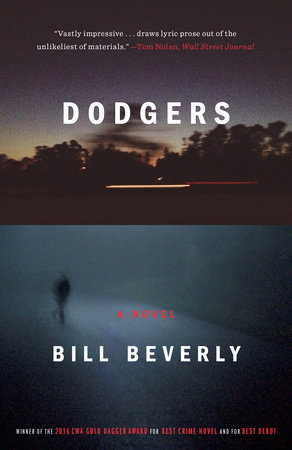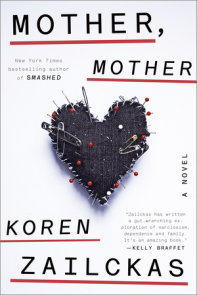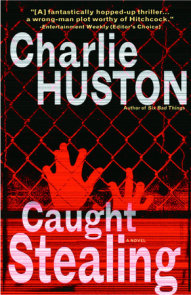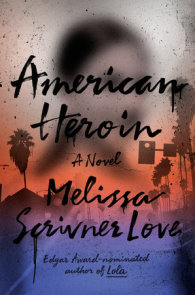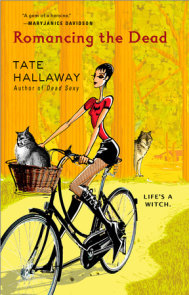TEACHING GUIDE
NOTE TO TEACHERS
Please click on the PDF link at the bottom of this page to download the Teacher’s Guide.
ABOUT THE BOOK
Every once in a while, the publication of a novel seems to come at the perfect time. Bill Beverly’s Dodgers is one of those novels: a coming-of-age narrative that navigates contemporary urban and rural landscapes with the same mythic gravitas that Cormac McCarthy’s Border Trilogy brought to the mid-century American Southwest. After a drug raid throws their underground organization into chaos, the young protagonist, East, is sent with his volatile half-brother and two other young men to travel across the country on a mission to kill a judge. Their journey away from Los Angeles and into a blighted rural American landscape forces East to come to terms with the choices he has made, ultimately revealing the man he will choose to become.
With Dodgers, Bill Beverly has written a novel that is immediate, accessible, and poetic in its depictions of both brutality and grace.
ABOUT THE AUTHOR
BILL BEVERLY grew up in Kalamazoo, Michigan, and studied at Oberlin College and the University of Florida. His research on criminal fugitives and the stories surrounding them became the book On the Lam: Narratives of Flight in J. Edgar Hoover’s America. He teaches American literature and writing at Trinity University in Washington, DC.
NOTE TO THE TEACHER
Dodgers is a literary and accessible coming-of-age novel featuring an African American protagonist. While race and identity play a role in the narrative, there’s also much more: family, loyalty, self-determination, and personal responsibility. These themes help to connect the book with canonical texts as diverse as Hamlet, East of Eden, and In Cold Blood.
Beverly’s protagonist, East, is a character that inspires empathy and challenges stereotypes. As a result, Dodgers is a novel that provides material for rich discussions and writing opportunities on contemporary issues and controversies.
Dodgers meets the CCSS for Range of Reading and Level of Text Complexity for 11th and 12th grade students.
For a complete listing of the Standards, go to: www.corestandards.org/the-standards.
PRE-READING ACTIVITIES
In reviews, Dodgers has been compared to The Catcher in the Rye. In both narratives, the reader is invited to view the world through the perspective of a young male protagonist trying to navigate a path to adulthood. While it is easy to recognize heroism in traditional epic narratives or works of fantasy or science fiction, it can be harder to recognize heroism in contemporary realistic works. This is especially true if the protagonist’s identity is different from one’s own. Before you read, use a film like Maria Full of Grace (2004) to begin a discussion of ways that characteristics of a hero’s journey can apply to narratives with a contemporary realistic setting. How does viewing a non-traditional figure—in the case of Maria, a young Hispanic woman—as a hero challenge our assumptions about what constitutes heroism? What unique challenges does she face based on her gender, ethnicity, and socioeconomic status?
As you read Dodgers, consider the ways that East’s gender, race, and socioeconomic status impact the way he interacts with the world. What challenges does he face simply because he is an African American male from an impoverished area of Los Angeles? In what ways is he heroic? In what ways isn’t he? How does East’s journey challenge your assumptions about heroism?
KEY IDEAS AND DETAILS
CCSS.ELA-LITERACY.RL.11-12.1 Cite strong and thorough textual evidence to support analysis of what the text says explicitly as well as inferences drawn from the text, including determining where the text leaves matters uncertain.
CCSS.ELA-LITERACY.SL.11-12.1.A Come to discussions prepared, having read and researched material under study; explicitly draw on that preparation by referring to evidence from texts and other research on the topic or issue to stimulate a thoughtful, well-reasoned exchange of ideas.
The following questions can be used as guiding questions for class discussion or as written prompts to check for understanding during independent reading.
Part I: The Boxes
1. What is your first impression of East? What qualities set him apart from the other boys that work in the yard?
2. Examine Beverly’s use of language on pages 9-10. How does the description of the drug raid contrast with the language used to describe the Jackson girl’s death?
3. Find details suggesting that Fin holds a great deal of power. Describe the relationship between Fin and East. Why does East feel like he did not have a choice about whether or not to be part of Fin’s crew?
4. What does Beverly reveal about East through the juxtaposition of East’s visit to his mother and the description of the basement where he lives?
5. Describe your first impressions of Michael Wilson and Walter. Why do you think they were each selected to be a part of the team?
6. Explain the details of the job that Fin assigns to the boys. Why are they told to pay cash, wear Dodgers shirts, and drive a minivan? How will they get the guns they need?
7. What message do you think Fin is sending when he pulls the gun on East? Did East’s response surprise you?
Part II: The Van
1. How does East demonstrate that he follows rules? How is he different from the other boys?
2. What does East do while they drive? What does Ty do? What impression does the changing landscape make on East? Contrast his response to the journey with Ty’s response.
3. Describe the trouble that the boys get into in Las Vegas. Who do you think is the most responsible for the situation? What does East realize about his brother after the altercation in Vegas?
4. How does Michael Wilson try to justify his decision to stop in Las Vegas? Why doesn’t East trust him? Why do the other boys consider him their leader?
5. Why did Michael Wilson get involved in Fin’s drug business? How do his reasons differ from East’s?
6. What makes East decide to drive the van? How does driving make him feel?
7. Contrast the response that East has at the scenic overlook to the response of the little kids in the white Navigator (81-2). What does East see that the kids seem to miss? What do the children experience that East seems to miss? Why do you think Beverly juxtaposes the two responses?
8. On page 85, East refers to Ty as “an unknowable child.” What do you think “made Ty what he’d become”? Why does East feel responsible for losing Ty? Is he responsible?
9. How does East respond when Maggie touches him (89)? What does his response reveal about his character?
10. Why does Maggie remind East of the Jackson girl? Why do you think he responds to her the way he does?
11. What causes Ty to turn against Michael Wilson? Why is East surprised by Ty’s actions?
12. What does East’s memory of being beaten up in the third grade reveal about his relationships with his mother, his brother, and Fin?
13. What does East learn about the role that Walter plays in Fin’s organization?
14. How does Beverly use description and setting to create mood and build suspense in the scenes involving the boys’ attempts to acquire guns?
15. Describe the physical reaction East has to the events that occur at the barn. What does his reaction reveal about him?
16. Explain the reasons for East’s visceral dislike of Matt and Philip (128).
17. How does the flashback on page 133 develop the relationship between East and Ty? Why do you think Beverly includes it at this point in the narrative?
18. Why is East upset about Ty’s intervention after the gun transaction (136)?
19. How does Walter know that the judge is still in town?
20. What do the boys learn when they call Abraham Lincoln for final instructions? Who makes the decision to go ahead with the plan to kill the judge? Why do you think he makes this decision?
21. What suggests the judge recognizes Ty?
22. After shooting the judge, the boys disagree about the next steps they should take. What causes East to realize, “Nothing he said or did meant anything in Ty’s mad story of the world”?
23. In chapter 14, Beverly switches his narration to refer to Ty and East as “the younger boy” and “the older boy” rather than by their names. How does his choice impact the unfolding of this chapter’s narrative?
24. Contrast Walter and East’s response to the shooting of Ty. Why do you think each boy responds the way he does?
25. What purpose does the flashback on pages 184-5 serve in the narrative?
26. What causes Walter and East to abandon the van?
27. What upsets East about the way that Martha Jefferson and Walter interact with each other? Why is he incapable of playing the role that Walter plays?
28. How does East respond to Walter’s farewell? Why do you think he responds this way?
29. What does East’s decision to retrieve the guns from the trash reveal about the way that he has changed?
Part III: Ohio
1. This section begins with a simile: “When he awoke, it was coming out of him like magma, like a volcano, punching a hole through the rock, spilling down his face” (211). How does this use of figurative language help develop East’s character?
2. How does Beverly develop East’s growing isolation and alienation? How does East rid himself of Martha Jefferson’s car? Why doesn’t he set it on fire the way his brother would have?
3. How can East tell that he frightens the girl making sandwiches in the gas station? What is it about him that frightens her?
4. What does East find on the outskirts of the town?
5. What purpose does the college that East visits serve in the narrative? Will college ever be an option for East? Explain your answer.
6. After showering at the college gymnasium, what is symbolically significant about the clothes East chooses to wear? What does he notice about his shoes?
7. Who are the Christian Wolves?
8. Why is the job at Slaughterrange attractive to East? What does it have in common with the work he used to do for Fin?
9. Examine specific ways that East demonstrates leadership during his time working for Perry. What does the way he manages his job reveal about his character? What does it suggest about his potential?
10. Why does East decide to contact Walter? What does Walter do for him?
11. What is Ty insinuating when he tells East, “Bet it wasn’t no white lady’s car you stole” (283)?
12. Why does East think that Ty is going to kill him? What reason does Ty give for not killing his brother? What does Ty tell East about his identity and his destiny?
13. At the end of the novel, what does East decide to do? Do you think he did the right thing?
classroom activity
CCSS.ELA-LITERACY.SL.11-12.5 Make strategic use of digital media (e.g., textual, graphical, audio, visual, and interactive elements) in presentations to enhance understanding of findings, reasoning, and evidence and to add interest.
Jean-Michel Basquiat was an African American artist whose style influenced street art aesthetics and challenged paradigms of wealth and poverty, race and class. Explore some of the works of Basquiat and choose one that you think relates to a theme or motif in Dodgers. Present an image of the painting along with a statement explaining the connections between the piece you selected and Beverly’s novel. For online collections of his work, visit the Basquiat estate’s website (basquiat.com) and the Basquiat page on Artsy (tiny.cc/basquiat).
CLASSROOM ACTIVITY
CCSS.ELA-LITERACY.W.11-12.7 Conduct short as well as more sustained research projects to answer a question (including a self-generated question) or solve a problem; narrow or broaden the inquiry when appropriate; synthesize multiple sources on the subject, demonstrating understanding of the subject under investigation.
CCSS.ELA-LITERACY.W.11-12.8 Gather relevant information from multiple authoritative print and digital sources, using advanced searches effectively; assess the strengths and limitations of each source in terms of the task, purpose, and audience; integrate information into the text selectively to maintain the flow of ideas, avoiding plagiarism and overreliance on any one source and following a standard format for citation.
Guns are ubiquitous in Beverly’s narrative, from the police guns that kill the Jackson girl in the opening scene, to Ty’s contraband gun, to the unregistered guns the boys solicit, to the paintball guns used as recreation at Slaughterrange. East, however, does not particularly like this weapon: “Guns, after all. Never had he cared for them. The noise, the mess. He’d held a gun before but never felt safer for it” (116). Is there a correlation between gun ownership and safety? What does the novel suggest about the role of guns? Why are some people, like Ty and the patrons of Slaughterrange, drawn to them? Research the growing epidemic of gun violence in America. What could be done to reduce gun violence? Debate these issues as a class.
CLASSROOM ACTIVITY
CCSS.ELA-LITERACY.SL.11-12.5 Make strategic use of digital media (e.g., textual, graphical, audio, visual, and interactive elements) in presentations to enhance understanding of findings, reasoning, and evidence and to add interest.
Dodgers is the narrative of a journey from Los Angeles to rural Ohio. Using details from the text and digital mapping, try to reconstruct the probable path of East’s journey, making reasonable guesses about the locations where he may have stopped and where key events in the narrative could have taken place. Examples of digital mapping projects are online at Georgia Tech’s Mrs. Dalloway project (tiny.cc/woolfmap) and the interactive map of The Catcher in the Rye from The New York Times (tiny.cc/salingermap).
CLASSROOM ACTIVITY
CCSS.ELA-LITERACY.W.11-12.7 Conduct short as well as more sustained research projects to answer a question (including a self-generated question) or solve a problem; narrow or broaden the inquiry when appropriate; synthesize multiple sources on the subject, demonstrating understanding of the subject under investigation.
CCSS.ELA-LITERACY.W.11-12.8 Gather relevant information from multiple authoritative print and digital sources, using advanced searches effectively; assess the strengths and limitations of each source in terms of the task, purpose, and audience; integrate information into the text selectively to maintain the flow of ideas, avoiding plagiarism and overreliance on any one source and following a standard format for citation.
CCSS.ELA-LITERACY.W.11-12.9 Draw evidence from literary or informational texts to support analysis, reflection, and research.
1. The treatment of African Americans by law enforcement is an issue that has become a subject of our national dialogue. How does Beverly address this issue in Dodgers? How aware are the boys that they are potential police targets? (See pages 83, 102, 214). Do all lives in the novel matter equally? What is significant about the way the police respond to Ty’s shooting? Would the response have been different if Ty had carjacked the white man at the gas station?
2. After the boys leave Los Angeles, Beverly is careful to suggest that crime and gangs are present in rural areas across America. Find specific examples that suggest the presence of organized crime outside of Los Angeles. How do these reminders of the presence of gangs impact the narrative?
3. Watch the following TED talk by Steven Levitt, author of Freakanomics: tiny.cc/levittvid. Based on this, how realistic is Beverly’s depiction of the way the business aspect of the drug trade works?
4. Based on the description of Fin’s houses, the behavior of the users, and the drug paraphernalia that East finds on the outskirts of town, what drug (or drugs) are involved? Research the growing epidemic of drug abuse in rural areas of America and propose a solution to help combat the crisis.
5. As East travels across America, he discovers a blighted landscape of small rural towns. In Ohio, Perry Slaughter comments on the way the landscape has changed: “All these boys . . . their daddies, fifty years ago, they worked foundry jobs, or machinists, or they were white collar: sales, teacher, bank. Everything. Drove to Cleveland, drove to Youngstown, had a pension, second house. Ohio exported more steel than Japan” (245). How has the loss of industry impacted the communities in Dodgers? What social problems are created when industries move overseas? What should be done about the communities that they leave behind? Focus your research on a specific community, like Detroit, that has been hit especially hard by globalization.
CLASSROOM ACTIVITY
CCSS.ELA-LITERACY.CCRA.R.9 Analyze how two or more texts address similar themes or topics in order to build knowledge or to compare the approaches the authors take.
CCSS.ELA-LITERACY.RL.11-12.7 Analyze multiple interpretations of a story, drama, or poem (e.g., recorded or live production of a play or recorded novel or poetry), evaluating how each version interprets the source text. (Include at least one play by Shakespeare and one play by an American dramatist.)
1. Beverly begins his novel with an epigraph from an 1849 slave narrative: The Fugitive Blacksmith. Examine the significance of starting Dodgers with a quote from a slave narrative. How does this epigraph help frame the novel? What does East’s story have to do with slavery and freedom? (Note: The Fugitive Blacksmith is available through Project Guttenberg at tiny.cc/fugitiveblacksmith)
2. On page 74, Michael Wilson quotes “The boy stood on the burning deck,” referencing East. This quote can be found in two poems: the 1826 poem “Casabianca” by Felicia Dorothea Hemans (tiny.cc/casabiancapoem1) and Elizabeth Bishop’s allegorical 1965 poem by the same name (tiny.cc/casabiancapoem2). How does this allusion help develop character and theme?
3. The term Shakespearean is used to describe a text that evokes a sense of the theme of a work by William Shakespeare. On pages 280-1 East contemplates his understanding of the world: “Injury called for injury. No need for organization. The rules of living were inside out.” Examine the ways that East’s internal conflict over his obligation to the rules of revenge and loyalty to Fin evoke themes and characters from Hamlet or another Shakespearean tragedy.
4. Analyze Dodgers as a modern interpretation of the Biblical story of Cain and Abel.
5. Truman Capote’s nonfiction masterpiece In Cold Blood examines the rural 1959 murders of the Clutter family. Evaluate the similarities between the way Beverly and Capote use language to establish setting, depict violence, and develop character.
CLASSROOM ACTIVITY
CCSS.ELA-LITERACY.W.11-12.1 Write arguments to support claims in an analysis of substantive topics or texts, using valid reasoning and relevant and sufficient evidence.
1. Dodgers ends ambiguously, with the protagonist adopting a new name and heading east. Beverly’s final observation is simple and haunting: “Alone, the first few stars in the unswept sky behind him. Then he was gone” (290). What do you think happens to East after the novel ends?
2. Research the differences between a hero and an antihero. Is East a hero or an antihero? Explain your answer using evidence from the text.
3. Examine the relationship between Perry Slaughter and East, a relationship that causes East some ambivalence. “Perry trusted him. But maybe trust was a trick. Maybe trust was the act that not trusting put on when there was no better alternative. Maybe trust was the trick that kept him working twelve, thirteen, fourteen hours a day” (243). Is Perry taking advantage of East, or does he genuinely care for him? Does East genuinely care about Perry?
4. Beverly writes: “East could rally a gang of boys his age, shepherd junkies in and out safely” (98). Over the course of the novel, how does East demonstrate leadership characteristics? Support your answer with relevant and specific evidence from the text.
5. On page 207, after Walter leaves and East retrieves the guns they had thrown away, there is the observation, “He was a bad man now” (207). This is the only time the terms “bad” and “man” are used to refer to East. Why does Beverly include this observation at this point? Whose perspective does it reflect? Do you agree with this judgment?
6. How big of a role does race play in Beverly’s novel? How would the story be different if East was a white kid?
7. Realistically, at the end of the novel, what options does East have? What external factors limit his options? In an ideal world, what should happen to him? What do you think would actually happen? Support your answer with logical evidence.
CLASSROOM ACTIVITY
CCSS.ELA-LITERACY.W.11-12.2 Write informative/explanatory texts to examine and convey complex ideas, concepts, and information clearly and accurately through the effective selection, organization, and analysis of content.
CCSS.ELA-LITERACY.W.11-12.9 Draw evidence from literary or informational texts to support analysis, reflection, and research.
1. The novel begins with an observation: “The Boxes was all the boys knew; it was the only place.” Consider the motif of boxes in the novel. What is the significance of naming the boys’ LA neighborhood the Boxes? Why does East seem attracted to the inside of boxes?
2. The second epigraph is a quote from the song “Death or Glory” by The Clash. How does this song relate to the themes of Dodgers? Consider the quote as it relates to the four boys in the novel. What does it mean to strike a bargain with the world? What bargain does each of the boys in the novel strike? Are their bargains worth the price they pay?
3. Examine East’s relationships with girls and women: “The old lady’s face returned to him, her pointed voice, and he heard her talking to Walter as he walked in the cold. He saw her looking at him. Or sometimes it was the face of the Jackson girl, leaking blood and going to sleep on the street, or the screaming mouth of the girl in Wisconsin” (218). Why do you think East has difficulty interacting with females? Why do memories of the Jackson girl haunt him?
4. There is a great deal of meaning associated with both the East and the West. For example, there is an American tradition of heading west to seek prosperity or a new beginning. Beverly, however, chooses to center his narrative around a migration east. Analyze the symbolic significance of this choice.
5. The tension between East and his half-brother Ty is one of the central conflicts in the narrative. Although the two boys are close in age, they have little in common. Beverly writes: “His brother, his blood, had different bones” (116). Analyze the relationship between East and Ty, paying particular attention to the way that the author uses flashback to develop character.
6. At one point, Walter tells East “You and I are the same type. We’re watchers. We manage” (155-6). Walter is the one character who remains loyal to East, and he’s the only character that expresses love for East. Analyze the development of the relationship between Walter and East.
7. Consider the passage on page 211: “He sobbed until it gave out. But he knew as it did that it changed nothing. No words, no pictures, no thought. It was just a trick of the muscles, a release of the glands.” What purpose does this scene serve in the narrative? How does it complicate or clarify your understanding of East’s character? Why do you think he finds it so difficult to process emotions?
8. Consider the attraction of Slaughterrange. How is East’s job at Slaughterrange similar to his job in the Boxes? Are there similarities between the clientele of Slaughterrange and the U’s in the Boxes? What purpose does this comparison serve in the narrative?
CLASSROOM ACTIVITY
CCSS.ELA-LITERACY.W.11-12.3 Write narratives to develop real or imagined experiences or events using effective technique, well-chosen details, and well-structured event sequences.
1. East thinks of himself as a watchman. Ty refers to himself as a contractor. Perry Slaughter describes himself as person who makes deals. If you had to describe yourself using a single word, what would you say?
2. Midway through the narrative, East finds out that Fin’s organization is in disarray; East is forced to make a decision about whether to abandon the mission or continue. Compose a narrative essay about a time when you had to make a significant decision on your own. How did you determine which action to take? Do you think you made the right decision?
3. While families can be a source of comfort and support, family relationships can also be challenging. This is especially true for East, who must navigate challenges in his relationships with his mother, father, and younger brother. Compose a personal essay about a family conflict. How was the conflict resolved? What did it teach you about yourself?
4. In Dodgers, East forms a bond with Perry Slaughter that serves, to some extent, as a surrogate parent/child relationship for both of them. Compose a personal narrative about your relationship with a significant mentor.
CRAFT AND STRUCTURE
CCSS.ELA-LITERACY.RL.11-12.4 Determine the meaning of words and phrases as they are used in the text, including figurative and connotative meanings; analyze the impact of specific word choices on meaning and tone, including words with multiple meanings or language that is particularly fresh, engaging, or beautiful.
1. Examine Beverly’s use of figurative language, especially his use of personification and the imagery he uses to describe natural vs. urban landscapes. How is East’s perception of the natural world different from romantic views of nature? Why do you think the mountains
make him physically ill? How does his perception of nature differ from his perception of urban areas?
2. What are the connotations of the names in the novel? For example, why is Michael Wilson called by both his first and last name? What about Perry Slaughter and Fin? How is East’s name symbolic? How does this symbolism relate to his journey? Are any of the names ironic?
3. Throughout the novel, Beverly develops the motif of a “dark string” inside of East (consider passages on pages 80, 90, 128, 151, and 201). What might this motif symbolize? How does it help develop character and theme?
4. Beverly’s prose is image-laden and lyrical: a style that may seem at odds with the genre of crime fiction. How does Dodgers both reflect and subvert conventions of the crime novel? How does Beverly’s style impact the reader’s understanding and experience of the narrative?
OTHER WORKS OF INTEREST
In Cold Blood by Truman Capote
Between the World and Me by Ta-Nehisi Coates
Clockers by Richard Price
East of Eden by John Steinbeck
Men We Reaped by Jesmyn Ward
Native Son by Richard Wright
ABOUT THIS GUIDE’S WRITER
Amy Jurskis is the author of a number of teaching guides, including The Immortal Life of Henrietta Lacks by Rebecca Skloot and In the Garden of Beasts by Erik Larson. She holds a BA in English from the University of Georgia and an MAT from Agnes Scott College. She currently serves as English Department Head at Oxbridge Academy, in West Palm Beach, Florida.
×
Become a Member
Just for joining you’ll get personalized recommendations on your dashboard daily and features only for members.
Find Out More Join Now Sign In








